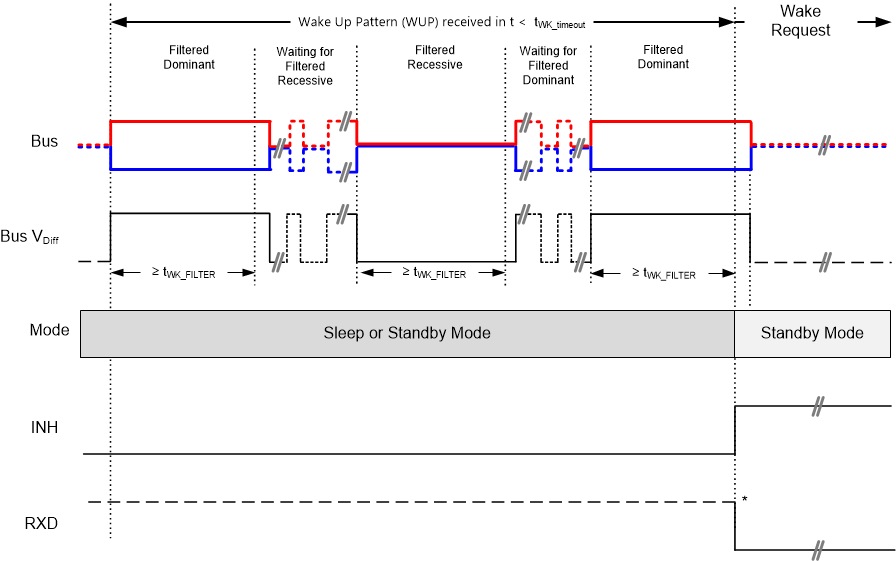ZHCSH19F November 2017 – November 2023 TCAN1043-Q1 , TCAN1043G-Q1 , TCAN1043H-Q1 , TCAN1043HG-Q1
PRODUCTION DATA
- 1
- 1 特性
- 2 应用
- 3 说明
- 4 Device Comparison Table
- 5 Pin Configuration and Functions
- 6 Specifications
- 7 Parameter Measurement Information
-
8 Detailed Description
- 8.1 Overview
- 8.2 Functional Block Diagram
- 8.3 Feature Description
- 8.4 Device Functional Modes
- 9 Application Information Disclaimer
- 10Device and Documentation Support
- 11Revision History
- 12Mechanical, Packaging, and Orderable Information
封装选项
机械数据 (封装 | 引脚)
散热焊盘机械数据 (封装 | 引脚)
订购信息
8.4.6.1 Remote Wake Request via Wake Up Pattern (WUP)
The TCAN1043xx-Q1 use the multiple filtered dominant wake up pattern (WUP) from ISO 11898-2 (2016) to qualify bus activity. The WUP is active for both sleep and standby modes and results in the RXD terminal being driven low after a valid pattern is received.
The WUP consists of a filtered dominant pulse, followed by a filtered recessive pulse, and finally by a second filtered dominant pulse. The first filtered dominant initiates the WUP, and the bus monitor then waits on a filtered recessive; other bus traffic does not reset the bus monitor. Once a filtered recessive is received the bus monitor is waiting for a filtered dominant and again, other bus traffic does not reset the bus monitor. Immediately upon reception of the second filtered dominant the bus monitor recognizes the WUP and transition to standby mode, drives the INH output high and sets the RXD terminal low (if VIO is present) to signal the wake up request.
For a dominant or recessive to be considered “filtered”, the bus must be in that state for more than the tWK_FILTER time. Due to variability in tWK_FILTER the following scenarios are applicable. Bus state times less than tWK_FILTER(MIN) are never detected as part of a WUP and thus no wake request is generated. Bus state times between tWK_FILTER(MIN) and tWK_FILTER(MAX) may be detected as part of a WUP and a wake request may be generated. Bus state times greater than tWK_FILTER(MAX) will always be detected as part of a WUP and thus a wake request will always be generated. See Figure 8-5 for the timing diagram of the WUP.
The pattern and tWK_FILTER time used for the WUP and wake request prevents noise and bus stuck dominant faults from causing false wake requests while allowing any CAN or CAN FD message to initiate a wake request.
If the device is switched to normal mode or an under voltage event occurs on either the VCC or VIO supplies, the wake request is lost.
ISO 11898-2 (2016) has two sets of times for a short and long wake up filter times. The tWK_FILTER timing for the TCAN1043xx-Q1 devices have been picked to be within the min and max values of both filter ranges. This timing has been chosen such that a single bit time at 500 kbps, or two back to back bit times at 1 Mbps triggers the filter in either bus state.

For an additional layer of robustness and to prevent false wake-ups, these devices implement a timeout feature. For a remote wake up event to successfully occur, the entire WUP must be received within the timeout value t < tWK_timeout (see Figure 8-5). If not, the internal logic is reset and the part remains in its current state without waking up. The full pattern must then be retransmitted, conforming to the constraints mentioned in this section and shown in figure Figure 8-5.